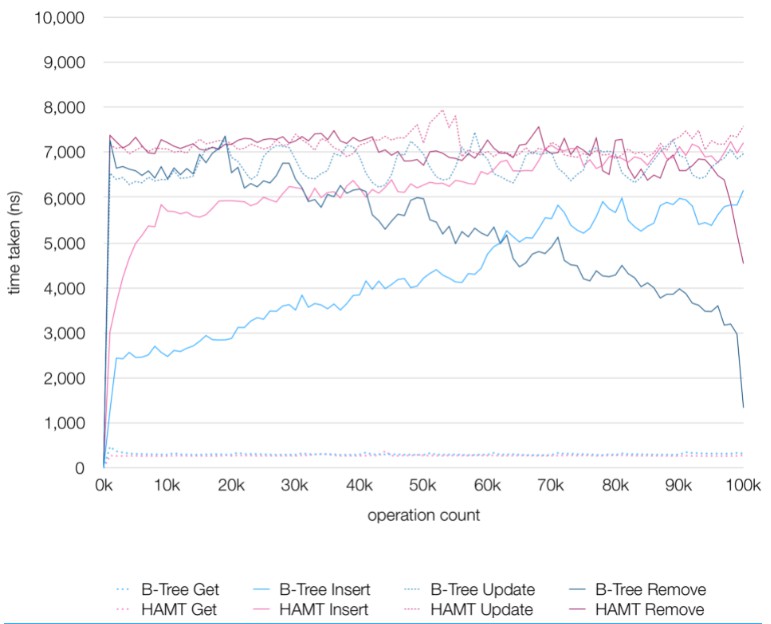HAMT (for Swift)
An implementation of HAMT(Hash Array Mapped Trie, Bagwell) in Swift. Eonil, May 2019.
Getting Started
Use HAMT type. This type provides these features.
- Hash-based key-value storage.
- All of read/write/copy
amortized O(log(n))time up to certain number of elements (see Performance section), andO(n)at worst. - Full “Copy-on-Write” behavior with minimal amount of copying.
The type provides these dictionary-like interfaces.
- Conformance to
Sequenceprotocol. - Conformance to
Equatableprotocol. isEmpty: Boolcount: Intsubscript(Key) -> Value? { get set }subscript(Key, default: @autoclosure () -> Value) -> Value { get set }keys: Sequencevalues: Sequence
These features are not supported (maybe yet).
Indexand index based look-up and iteration.- Any other collection protocol conformance.
Copy-on-Write Persistence
As like most Swift datastrctures, HAMT is also fully CoW compliant. This means each copy of same HAMT tree shares data as much as much possible. Regardles of how many copies you make, HAMT shares most portion of tree with all other copies.
Performance
HAMT type in this library is designed to be used as persistent datastructure.
In copy-persistent scenario under 64-bit environment, HAMT provides near constant time (O(log(n)) & max depth=10, -> O(10)) single element read/write/copy performance up to hash resolution limit ((2^6)^10 items) regardless of contained item count if hash function is well distributed. Also new copy does not take extra space unless gets mutated. Copy with single element mutation takes O(log(n)) extra time and space. On the other hand, copying Swift.Dictionary takes O(n) time and extra space.
Instead, single element read/write of HAMT is about 2x/50x times slower than ephemeral Swift.Dictionary for random 64-bit integer keys and values.
Note that “operation count” in above graph is accumulated number.
Here’s another performance comparison with copying B-Tree. Naive Swift.Dictionary is not drawn here because read/write performance is same with ephemeral one, and copying it takes too much time and didn’t finish.
For small dataset, naive copying of Swift.Dictionary works better, but as copying cost increases linearly, it is no longer efficient after 1,000 items.
Therefore, HAMT is better if you need a hash-based persistent associative array data structure that can grow more than several thousands.
B-Tree shows better write performance overall. HAMT performs better after 100K items, but it doesn’t seem to be really practical numbers. And it requires keys to be Comparable. By the way, as B-Tree doesn’t have hash collision, it’ll show more reliable performance.
Maintenance
HAMT type is implemented using PD5Bucket64 internally. PD5Bucket64 type provides all additional properties for testing and validation. PD4 type was an implementation of hash-trie, and deprecated due to high rate of wasted memory. PD5 implements HAMT and shows nearly same performance with PD4 with far less memory consumption.
I used PD5 prefix for convenience only for internals. Public major type name is HAMT, and internal types all use PD5 prefixed. If I implement a next version of algorithm, it’ll be named as PD6.
If once implementation gets stabilized, maybe I’ll rename all PDx prefixes to HAMT someday.
At this point, only 64-bit platforms are considered. It should work on 32-bit platforms but less performance and have not been tested.
Caution!
If you link this library, you’ll notice the performance is not good as shown in the graph. As like Károly Lőrentey clarified, it’s because Swift compiler does not inline and optimize over externally linked functions. You can compile HAMT source code with your code together in same module to archive best possible performance.
Credits
-
See also “B-Tree for Swift” by Károly Lőrentey if you need sorted associative array.
-
For more information about HAMT, see the paper by Phil Bagwell.
Contribution
Sending contribution means implicit agreement to redistribute your contribution under “MIT License”.
License
This code is licensed under “MIT License”. Copyright Eonil, Hoon H.. 2019. All rights reserved.



